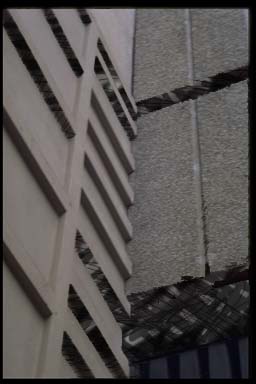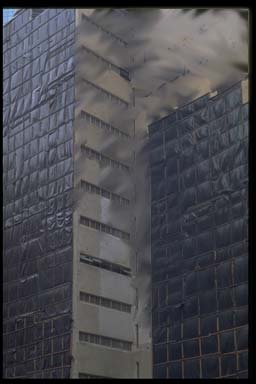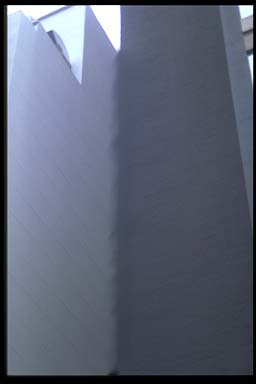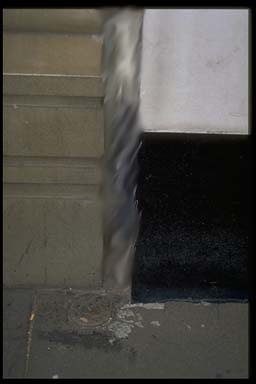
Spatial Resistance

"If it is true that a spatial order organises an ensemble of possibilities (e.g., by a place in which one can move) and interdictions (e.g., by a wall that prevents one from going further), then the walker actualises some of these possibilities. In that way, s/he makes them exist as well as emerge. But s/he also moves them about and...invents others, since the crossing, drifting away, or improvisation of walking privilege, transform, or abandon spatial elements...." [1]
From this initial quote I want to develop the possibilities of negative spatial resistance by developing two points:
1. The modernist city has placed disparate autonomous structures together. This placement speaks out about the pursuit of a singular rather than the social. Whereas the left-over space speaks of the social aspects forgotten about in this equation.
2. The second point is the relationship of telecommunications to the city describes the concept of interconnectivity. This interconnectivity places importance on the flow of information as a vehicle of integration.
So on the one hand we have the lack of connectivity through the autonomy of the cites architecture and the supposed connectivity through telecommunications.
Two autonomous central business district buildings  place side by side can create a residual negative space. This negative space is a left over space which becomes lost to the positive attributes of the buildings. The buildings which are being driven spatially by corporate concerns have a clear agenda. These corporate concerns are also driving the new forms of information technology.
place side by side can create a residual negative space. This negative space is a left over space which becomes lost to the positive attributes of the buildings. The buildings which are being driven spatially by corporate concerns have a clear agenda. These corporate concerns are also driving the new forms of information technology.
The negative spaces between these buildings is to be seen as an area of resistance. This resistance is made visible when the negative space is reversed to be seen in the positive. The space either side, the buildings themselves are seen as negative.
As Paul Virillo states
"Together with the build-up of information superhighways we are facing a new phenomenon: loss of orientation. A fundamental loss of orientation complementing and concluding the societal liberalization and the deregulation of financial markets whose nefarious effects are well-known. A duplication of sensible reality, into reality and virtuality, is in the making. A stereo-reality of sorts threatens. A total loss of the bearings of the individual looms large. To exist, is to exist in situ, here and now, hic et nunc. This is precisely what is being threatened by cyberspace and instantaneous, globalized information flows". [2]
This loss of orientation which Virillo speaks of is in its very essence housed within these left over spaces. These gaps become areas of resistance, not just unconscious constructions but part of network of connected spaces all reflecting similar circumstances. The gaps are emerging as positive spaces within this conyext, they demand attention through their consistency. This is the consistency of revealing how marked boundaries have been placed as barriers for no interaction. There is a lack of cohesion within these spaces;
the lack of thought
the disparate building materials
the lack of concept
the lack of completion
the lack of design
the building debris . 
Within this confusion there is the human social element which is sees these spaces as areas of functionality
the place to urinate
the place to stuff litter
the place to write slogans
the place to shelter
the place to view
Marcos Novak states
"Our understanding of territory is undergoing rapid and fundamental changes: within the scope of pragmatic experience both space and community are rapidly becoming non local" [3]
What is needed is new comprehension of spatiality.
"Thus the history of perspective may be understood with equal justice as a triumph of the distancing and objectifying sense of the real, and as a triumph of the distance-denying human struggle for control; it is as much a consolidation and systematisation of the external world as an extension of the domain of the self." [4]
At this time the perspectival spatiality that we use is being reinvented The problem with this reinvention is that it seems to belong to the corporate sector. The artist and architects need to become pro-active to have a voice in this evloution. The problem has been to let the invlovment with the post modern theory create a what seems to be a of lack of sustainable ground on which to base some resistance.
 When seen as a positive the left-over spaces no matter how small the space may be it still has the power as a social indicator to intercede and resist
When seen as a positive the left-over spaces no matter how small the space may be it still has the power as a social indicator to intercede and resist
1. Jordan Crandall Bioinformatic Alignments
2.http://www.ctheory.com/a30-cyberspace_alarm.html
3.Marcos Novak transmitting Architecture: The Transphysical City
4. Erwin Panofsky Perspective as Symbollic Form. Zone Books New York.
